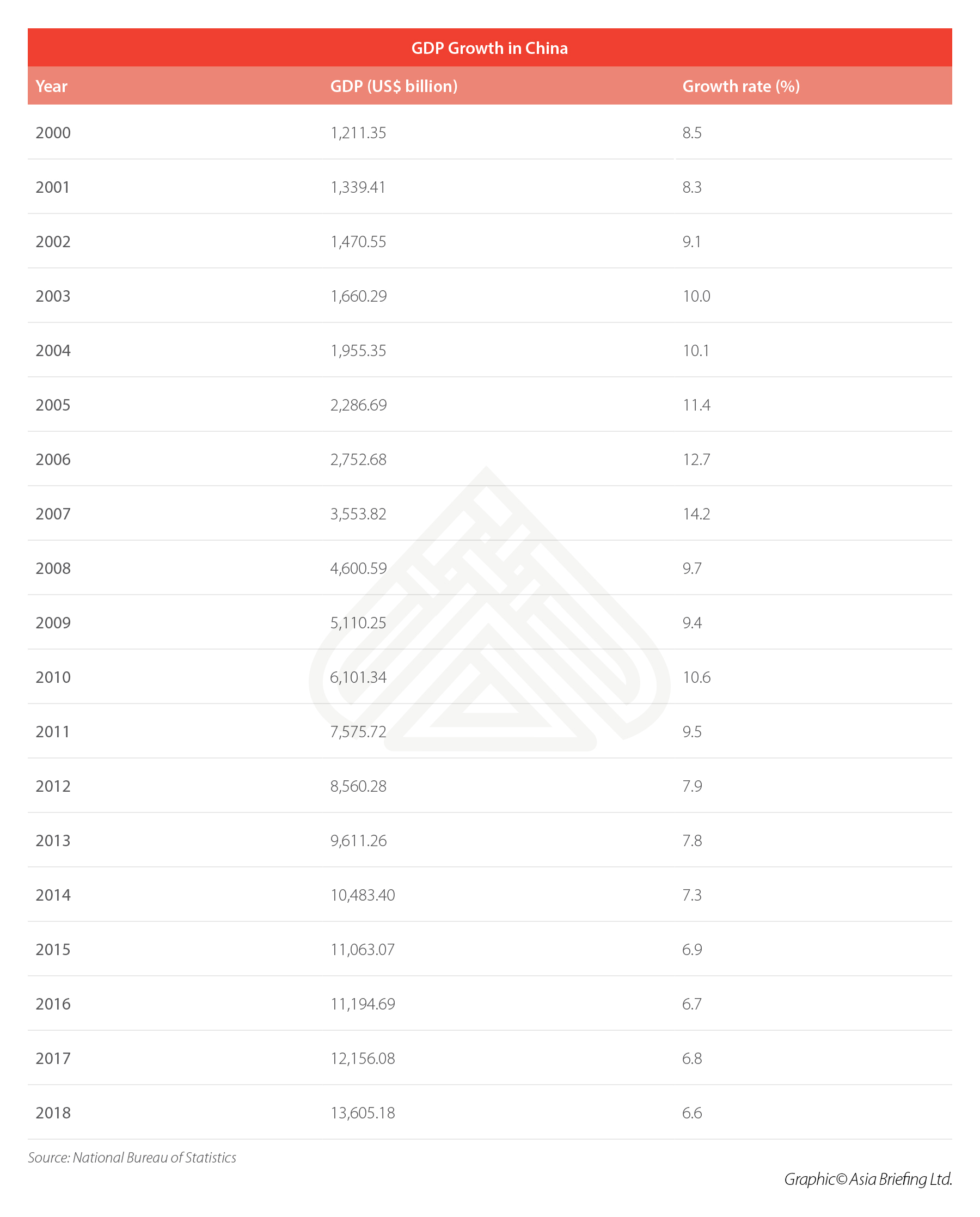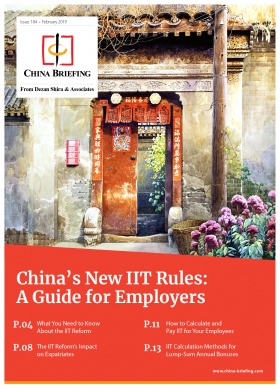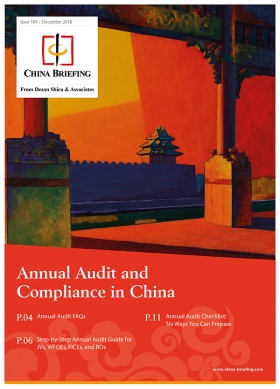Why Should We Care About China’s GDP Growth?

China recently released its economic data for the second quarter of 2019, announcing GDP growth of 6.2 percent, down from 6.4 percent in the first quarter.
As is the case whenever China releases economic data, media outlets were quick to publish familiar stories about how the country’s economy is slowing, now with added drama as China and the US are in the midst of a trade war.
Many of these articles offered ominous takes like “China second-quarter GDP growth slumps to lowest in 27 years as the trade war hits”, “China’s Economy Falters; Slowest Growth In Nearly 3 Decades”, and “China’s Economic Growth Is at Its Lowest in Almost Three Decades”.
While not entirely inaccurate, these headlines present a misleading idea about the state of the Chinese economy – such as it being on the verge of collapse. In reality, China’s growth has been gradually slowing for years, and the latest data merely confirms the trend.
While the print that follow these headlines often acknowledge this nuance, they do enough to spread a particular impression of China’s economic performance.
Contextualizing China’s GDP growth figures
The GDP statistics that confirm the ongoing Chinese slowdown are important – just not always in the way they are presented in much of the media. To make real sense of China’s GDP figures, they need to be placed in context.
When comparing China’s current growth with that in its past, the most obvious qualifier is that it is building off a far larger base than before. China is, after all, the world’s second-largest economy, growing at 6.6 percent in 2018 to reach US$13.6 trillion in GDP.
In 2003, when China kicked off the first of five consecutive years of double-digit growth, its GDP had stood at only US$1.66 trillion.
In 2010, the last time China grew at double-digit rates, its GDP was US$6.1 trillion – less than half the size of what the country’s economy is today.
This point is frequently raised by both analysts and government spokespeople, who note that the economic base is so much larger now than in the past that China adds the equivalent of Australia’s national economy each year.
Moreover, most economists argue that slower growth is inevitable as China’s economy matures.
China has already outperformed all other countries in recent history with its incredible speed, scale, and consistency of economic growth.
China managed eye-popping growth figures during its boom years by building desperately needed infrastructure and housing, while a perfectly timed demographic dividend provided an enormous pool of cheap labor.
Over time, however, returns from these investments have been diminishing and the country’s working-age population has been rapidly aging – contributing to the decelerating growth.
When it comes to analyzing China’s economic performance in a given year or quarter, though, there is an elephant in the room: the country’s unreliable statistics. China’s methods for calculating GDP growth are opaque and, some argue, frequently altered to meet growth targets, while regional officials are incentivized to doctor data for career advancement.
As a result of years of manipulation, some economists argue that the official statistics paint a warped picture of the size of the economy.
For example, a study published by Brookings found that China’s GDP growth was exaggerated by an average of 1.7 percentage points per year from 2008-2016, meaning that the size of the economy is actually 18 percent smaller than officially reported.
China’s statistics are so unreliable that the country’s own leaders do not trust or use them, as was revealed in cables released by WikiLeaks.
In a similar vein, researchers recently found that China’s population might be lower by 90 million people than official statistics suggest – larger than the entire population of Germany. If government statisticians can’t even count the number of people in the country, can they be trusted to accurately measure total economic activity?
Veracity is therefore a question that hangs over the release of any data in China.
Why tracking GDP growth is still important
Still, even if growth is coming from a much larger base than in the past and is largely expected, slowing GDP growth remains an important concern.
It is worth remembering that although slower growth is now seen almost as a historical given, that was not always the case.
In 2007, for example, the late Nobel-winning economist Robert Fogel argued that economists actually underestimated China’s capacity for growth and that it would grow at an average of eight percent per year until 2040 off the back of its domestic market and education system.
In 2009, the economists Uri Dadush and Bennett Stancil offered a more conservative but still striking prediction that China would grow by 5.6 per year to 2050. Compared to projections such as these, China’s economy is perhaps slowing down faster than expected a decade ago.
Because of the size of China’s economy, any slowdown will have global effects. Last year, China accounted for about 30 percent of global GDP growth – despite showing a slower growth rate than past years.
If growth continues to slow, the effects will be felt worldwide – especially in terms of demand for commodities – even if the deceleration does not constitute an economic crisis. For example, Australia sends 30 percent of its exports to China, driven by products like coal and iron ore, leaving it exposed to fluctuations in Chinese demand.
Domestically, slowing GDP growth poses a more dire threat.
Handicapped by mountains of debt and lower returns on investment, China can’t afford wide-ranging stimulus to sustain growth, and rising land and labor costs have hurt its ability to produce cheap exports. Although domestic consumption is one of the largest drivers of China’s economy, the sector still requires more development to compensate for losses elsewhere.
Lower growth would therefore be embraced by China’s leaders in the long-term if it is a reflection of a more developed and sustainable economy.
Therein lies the real challenge for China – not whether it will be able to rebound from middling growth in Q2 2019, but whether it can successfully reform its economy so that it can build sustainable growth in the long-term.
Higher growth gives economic planners more breathing room in obtaining this goal but fretting over a few tenths of a percentage point loses sight of the higher stakes at hand.
The politics behind China’s GDP growth
Besides the uncertainty caused by the trade war, the risks facing China’s economy are largely structural rather than short-term. Still, tracking quarterly GDP growth statistics – regardless of their accuracy – is worthwhile because of their political importance.
For years, China’s leaders have touted the country’s high GDP growth to boost their political legitimacy, and the unveiling of the GDP growth target at the annual Two Sessions meetings is now a staple of Chinese political theater.
Further, China’s political system is so opaque that there are limited avenues to search for credible alternatives to what the government releases, nor can the government’s policy agenda be easily discerned. To a certain degree, the opacity of GDP figures paradoxically adds to the weight it is given.
In a purely market-driven economy, if a politician sets a growth target, it is in many ways an aspirational figure that they might be graded on.
In China, because the government has a high level of involvement in the economy and can manage, to an extent, the statistics themselves, GDP growth figures become clues towards the government’s future behavior.
For this reason, the announcement of the GDP growth target is carefully parsed for the exact language used in how it is presented, such as whether it is a specific number, a range, or if any qualifiers are given.
And because meeting these targets are so politically important, a given quarter’s GDP growth suddenly becomes important when it might not be particularly consequential otherwise.
In 2019, for example, Q1 growth of 6.4 percent and Q2 growth of 6.2 percent put the government on track to meet its target of 6-6.5 percent. That means new government spending to boost growth might be unlikely for Q3, but could be on the cards later in the year if quarterly growth falls below six percent.
The exact GDP growth figures themselves might not reveal much about the real state of China’s economy, but that does not necessarily matter for the political needs of meeting the targets. China GDP growth figures, then, are useful more so for understanding what the government is likely to do in the future rather than to understand the economy at the present.
Chinese leaders and independent economists largely agree that GDP figures should not be obsessed over, and instead should be used as one parameter in a holistic analysis of the economy.
Yet, their political importance in China inevitably brings GDP growth under constant scrutiny.
In an attempt to gradually transition attention away from a ‘growth at all costs’ mentality, China’s economic planners in recent years have been pushing the narrative of a “new normal” of slower but more sustainable “higher quality” growth.
Chinese officials say that they will place more emphasis on statistics such as unemployment and housing affordability as part of this new emphasis on quality growth – measures that are more important for regular people’s day-to-day lives. This concept comes alongside greater efforts to protect the natural environment, which has been devastated after decades of unrelenting growth.
While these ideas are certainly convenient and somewhat self-serving, to an extent they do reflect real changes in needs and priorities.
Whether or not quality measures give a more accurate view of the health of China’s economy can be debated. But with China’s economy at a crossroads and the country embroiled in a trade war with the US, the focus on GDP growth is unlikely to go away any time soon, regardless of what economic planners might wish.
About Us
China Briefing is produced by Dezan Shira & Associates. The firm assists foreign investors throughout Asia from offices across the world, including in Dalian, Beijing, Shanghai, Guangzhou, Shenzhen, and Hong Kong. Readers may write to china@dezshira.com for more support on doing business in China.
- Previous Article Serious Investors Have Already Moved Past US-China Gripes
- Next Article Disregarding Tariffs, the New American Sourcing and Manufacturing Mantra: “In China, For China”











